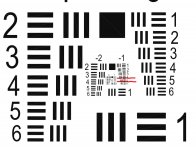absolut_beethoven
Well-known member
I'm confused by the resolution test results. Was it inconclusive due to the tripod mount issue? Or, were you able to tell which bin is sharper ?
I apologize for the confusion. It would have been easier if they had used numbers and letters, but because of its layout and the way the different columns and rows are numbered I slipped up in making it clear enough.
I have enclosed a pic of the chart in order to clarify my findings. There's a large black square right in the middle of the chart near the top. On the right hand side below that square is column -1. If you follow my two poorly drawn red lines you'll see that the upper one is pointing to the 2nd row in column 1 (not the larger set in column -1) and the lower line is pointing to the last row, #6 of the same column.
My unaided eye could easily make out both vertical and horizontal bars of the larger set that the upper red line is pointing to and with the Zeiss tripler I could do the same for the last row in that column that the lower red line is pointing to.
When looking at this chart here's a few things to keep in mind. Size wise, the enclosed pic on my 24" screen is within a millimeter or two of the printed version that I use for these tests. I view the chart from a distance of about 20' and with my 1.5X magnification reading glasses I can barely even see those lines in the 6th row of the 1st column from less than 12". When I managed to keep my hand still enough every now and then I did get a clear glimpse of the next smaller set with the Zeiss. That, coupled with the slightly sharper stars it showed, leads me to believe that doing the aforementioned test using both the correct bino harness and tripler adapter would clearly show its slightly higher resolution/sharpness. Hopefully that clarifies this test for you.






